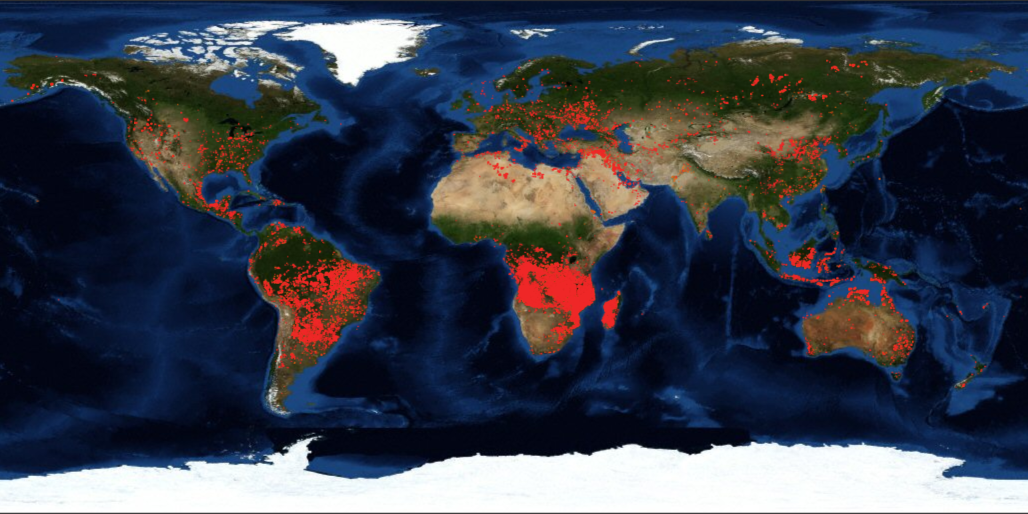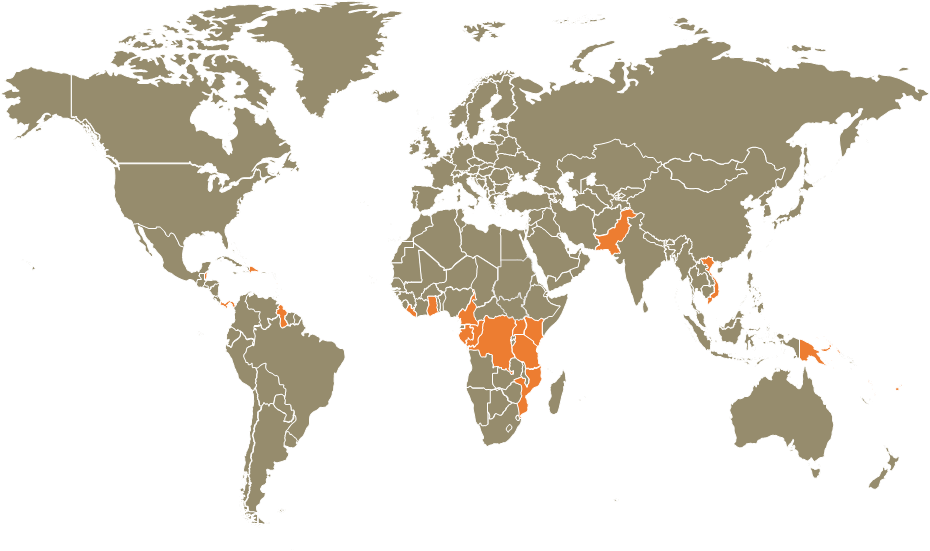Countries primed for fundraising to save forests
Countries primed for fundraising to save forests
The Results-based Reporting for REDD+ project has worked with tropical countries across the world, to improve their data-gathering on forest cover and reporting to the United Nations. This has laid the groundwork for increased funding to protect and restore forest lands. The project couldn't have been more timely - as Matt Gilbert of PwC reports. This Part 1 of a two-part blog; read Part 2 here.
Recent images of forest fires across the Amazon rainforest have caught the attention of the world. There have been more than 74,000 fires in Brazil this year, an increase of 84% on the same period of last year, more than half of which are in the Amazon. Fires in the Congo basin may even be greater in extent. However, these are not isolated or one-off events. Demand for agriculture is driving land clearance and climate change induced changes in weather will continue to increase the likelihood, scale and impact of wildfires globally.
Figure 1: NASA Satellite map of fires in the last 24 hours (29/08/2019). Source: NASA (2019)
Forests have an essential role to play in the fight against climate change. They absorb approximately 2.6 billion tonnes of CO2 each year and store billions more. Research has shown that Natural Climate Solutions[1] have the potential to deliver 37% of the emissions reductions needed to limit global warming to 2°C. Forests also provide important ecosystem services such as clean water and healthy soils, hold high levels of endemic biodiversity, and are essential to the livelihoods of over one billion people.
Halting deforestation and speeding up reforestation and afforestation are crucial if the world is to meet the limits agreed in the Paris Agreement. Signed by 195 governments in December 2015, the agreement committed countries to keep average global temperature change to less than 2°C above pre-industrial levels and as close to 1.5°C as possible. Governments agreed to significantly cut global greenhouse gas emissions in order to achieve this target.
The recent Intergovernmental Panel on Climate Change (IPCC) Special Report on Climate Change and Land released in August 2019 reaffirmed the significance of emissions from agriculture, forests and land-use (AFOLU). They account for almost a quarter of total human-caused CO2 emissions, with deforestation and peatland degradation contributing the majority of this. However protecting forests is a complex challenge. Forests face multiple demands which are likely to intensify as the climate crisis worsens. Increasing food production can be at odds with expanding bioenergy or preserving forests as carbon stores. Measures to support forest-rich countries in reducing deforestation and forest degradation are essential. However, often these are in developing countries where policies, law enforcement and finance flows are inadequate.
REDD+ (reduced emissions from deforestation and forest degradation) initiatives can help address the financing gap in forest conservation. REDD+ refers to a mechanism developed by countries under the United Nations Framework Convention on Climate Change (UNFCCC) to create financial value for the carbon stored in forests, offering incentives for developing countries to conserve and restore forest lands, through the receipt of results-based payments. Countries seeking to receive these payments must submit greenhouse gas inventories to the UNFCCC, a process which requires accurate measuring and reporting.
Despite offering large-scale cost-effective emissions reductions, there has been limited investment and prioritisation by governments in REDD+ solutions, as a lack of robust data and technical capacity, financial capabilities and often insufficient political will often hinder progress. The Norweigan government has been a major supporter of solutions to address this gap, investing several billion dollars into projects aimed at conserving tropical forests and reducing the associated greenhouse gas emissions and funding capacity-building in countries with payments based on verified results.
One such initiative is the Reporting for Results-based REDD+ (RRR+) project. This three-year project (2016-2019) set out to build capacity for measuring and reporting on reductions in greenhouse gas emissions and enhancement of carbon stocks in agriculture, forestry and across other types of natural land use (the AFOLU sector) in 21 tropical and subtropical forest countries. The project was funded by the Norwegian Agency for Development Cooperation (NORAD) through the UK Department of International Development (DIFID) and implemented by the Coalition for Rainforest Nations (CfRN) and PwC on behalf of the Climate and Development Knowledge Network.
Figure 2: RRR+ project countries
RRR+ project provided training and support to assist developing countries to produce more technically robust inventories of domestics greenhouse gas emissions from forests and other natural land uses, compliant with the methods and guidelines stipulated by the IPCC - the international authority on reporting emissions and carbon stocks. This not only provides countries with a better understanding of their AFOLU sector, it also provides greater market confidence in the data, which is essential for enhancing the flow of REDD+ finance. The project principally worked with technical specialists for these countries with the ultimate goal of helping these countries to secure results based REDD+ payments.
Every country has a different timeline and starting point when preparing a greenhouse gas inventory and support was tailored to take into account the differing circumstances, timelines and reporting goals of each country. Successfully developing and reporting a greenhouse gas inventory requires the coordination of individuals and institutions from both the public and private sectors, as well as the cooperation of local communities. The project encouraged the participation of civil society organisations, businesses, investors, local and subnational governments and line ministries, researchers and academics in its workshops and outreach activities.
To receive results-based finance, countries must submit greenhouse gas inventories to the UNFCCC. This requires accurate measuring and reporting as well as formal institutional arrangements defining the roles and responsibilities of relevant stakeholders and institutions. Many of the countries supported previously had limited experience in these complex processes; no project country had submitted a Forest Reference Emission Level (FREL) and/or Forest Reference Level (FRL)[2] prior to the support of RRR+. A FREL/FRL, which is part of a greenhouse gas inventory, is a necessity to participate in REDD+.
The project provided participating countries with training through in-country missions on how to strengthen institutions, systems and processes to report their greenhouse gas emissions and removals to the UNFCCC via the official process: the National Communication[3] and Biennial Update Report[4] cycles. As a result of the support, thirteen countries[5] have reported an enhanced understanding of the national institutional arrangements required for greenhouse gas inventory compilation and reporting, and eleven countries[6] have successfully produced greenhouse gas inventories in the AFOLU sector ready to be included in their National Communication and/or Biennial Update Reports, consistent with the IPCC Guidelines.
Carlos Gómez, REDD+ Coordinator and UNFCCC REDD+ negotiator for Panama commented:
“For Panama, the support of RRR+ to construct an FREL was very important. We did not have any experience in this process or creating a greenhouse gas inventory previously. Given the complexity and technical nature of this process, the support of the RRR+ project has been critical in helping country practitioners in Panama to produce a FREL consistent with the 2006 IPCC Guidelines.”
The project also provided important opportunities for knowledge exchange through its series of global and regional workshops. During the 2017 regional workshop held in the Dominican Republic, for example, officials from Panama and Belize met and were able to assist one another with data collection.
Edgar Correa, Forest Officer at the Belize Forest Department commented:
“We met with officials from Panama during the regional workshop in Dominican Republic. We were able to receive assistance from the project for Panama to come to Belize to help with our data collection. Through this process they were able to help us work through challenges that they had also faced. The project was also important in getting internal buy-in and credibility from the government.”
For more on the project's activities and how tropical forest countries are building their capacity to measure the carbon stocks in forests, read the follow-up article here.
Image: Kenya monitoring, courtesy CIFOR.
[1] Conservation, restoration, and improved land management actions that increase carbon storage and/or avoid greenhouse gas emissions across global forests, wetlands, grasslands, and agricultural lands
[2] To participate in REDD+, countries must develop a Forest Reference Emission Level and/or Forest Reference Level. These are benchmarks for assessing their performance in implementing REDD+ activities. Reference levels need to be consistent with the country’s greenhouse gas inventory estimates.
[3] National Communication - Non-Annex I Parties are required to submit their first NC within three years of entering the Convention, and every four years thereafter.
[4] Biennial Update Reports - reports to be submitted by non-Annex I Parties, containing updates of national Greenhouse Gas (GHG) inventories, including a national inventory report and information on mitigation actions, needs and support received.
[5] Belize, Cameroon, Democratic Republic of Congo, Dominican Republic, Fiji, Guyana, Kenya, Liberia, Mozambique, Panama, Republic of Congo, Saint Lucia and Uganda.
[6] Belize, Democratic Republic of Congo, Fiji, Ghana, Kenya, Liberia, Panama, Pakistan, Papua New Guinea, Republic of Congo and Uganda.


